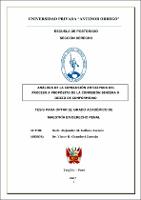Mostrar el registro sencillo del ítem
Análisis de la conclusión anticipada del proceso a propósito de la confesión sincera o juicio de conformidad
| dc.contributor.advisor | Chanduví Cornejo, Víctor Hugo | |
| dc.contributor.author | Galloso Asencio, Alejandro M. | |
| dc.creator | Galloso Asencio, Alejandro M. | |
| dc.date.accessioned | 2018-01-29T14:54:50Z | |
| dc.date.available | 2018-01-29T14:54:50Z | |
| dc.date.issued | 2017 | |
| dc.identifier.uri | https://hdl.handle.net/20.500.12759/3503 | |
| dc.description.abstract | La Tesis que hemos denominado “Análisis de la Conclusión anticipada del proceso a propósito de la confesión sincera o juicio de conformidad” se orienta a determinar cómo se manifiesta la aplicación de la figura jurídica de la Conclusión anticipada del proceso a nivel del Distrito Judicial de La Libertad, en el marco de la regulación del proceso penal peruano. La Conclusión anticipada constituye un mecanismo legítimo de simplificación procesal con el objeto de aliviar la sobrecarga procesal de los tribunales nacionales, así como ofrecer a los justiciables un mecanismo expeditivo en la administración de las causas en el sistema judicial. En este sentido, la formulación de nuestro Problema fue el siguiente: ¿DE QUÉ MANERA SE MANIFIESTA LA APLICACIÓN DE LA CONCLUSIÓN ANTICIPADA DEL PROCESO A NIVEL DEL DISTRITO JUDICIAL DE LA LIBERTAD, EN EL MARCO DEL PROCESO PENAL PERUANO?, frente a lo cual nos planteamos los siguientes objetivos principales: Conocer los aspectos generales del proceso penal y las motivaciones jurídicas de la reforma en el ordenamiento procesal en nuestro país; Analizar los fundamentos y principales características de la Conclusión anticipada en el marco del Nuevo Código Procesal Penal; Conocer, mediante entrevistas o sondeos de opinión, la posición de una muestra específica de Jueces y Fiscales en torno a la aplicación de la Conclusión anticipada en el distrito judicial de La Libertad. | es_PE |
| dc.description.abstract | The thesis that we have called ““Analysis of the anticipated conclusion of the process regarding sincere confession or conformity assessment““ is aimed at determining how the application of the legal figure of the anticipated conclusion of the process at the level of the Judicial District of La Libertad , Within the framework of the regulation of the Peruvian criminal process. The Anticipated Conclusion is a legitimate mechanism of procedural simplification in order to alleviate the procedural overload of national courts, as well as to provide individuals with an expeditious mechanism for the administration of cases in the judicial system. In this sense, the formulation of our problem was as follows: HOW DOES THE APPLICATION OF THE ANTICIPATED CONCLUSION OF THE PROCESS AT THE LEVEL OF LA LIBERTAD JUDICIAL DISTRICT, IN THE FRAMEWORK OF THE PERUVIAN PENAL PROCESS? The following main objectives: To know the general aspects of the criminal process and the legal motivations of the reform in the procedural order in our country; Analyze the foundations and main characteristics of the Anticipated Conclusion in the framework of the New Code of Criminal Procedure; To know, through interviews or opinion polls, the position of a specific sample of Judges and Prosecutors regarding the application of the Preliminary Conclusion in the judicial district of La Libertad. | en_US |
| dc.description.uri | Tesis | es_PE |
| dc.format | application/pdf | es_PE |
| dc.language.iso | spa | es_PE |
| dc.publisher | Universidad Privada Antenor Orrego - UPAO | es_PE |
| dc.relation.ispartofseries | T_MAEST.DERE_092 | |
| dc.rights | info:eu-repo/semantics/openAccess | es_PE |
| dc.source | Universidad Privada Antenor Orrego | es_PE |
| dc.source | Repositorio Institucional - UPAO | es_PE |
| dc.subject | Conclusión anticipada | es_PE |
| dc.subject | Juicio de conformidad | es_PE |
| dc.title | Análisis de la conclusión anticipada del proceso a propósito de la confesión sincera o juicio de conformidad | es_PE |
| dc.type | info:eu-repo/semantics/masterThesis | es_PE |
| thesis.degree.level | Maestría | es_PE |
| thesis.degree.grantor | Universidad Privada Antenor Orrego. Escuela de Postgrado | es_PE |
| thesis.degree.name | Maestro en Derecho con Mención en Derecho Penal | es_PE |
| thesis.degree.discipline | Maestría en Derecho | es_PE |

